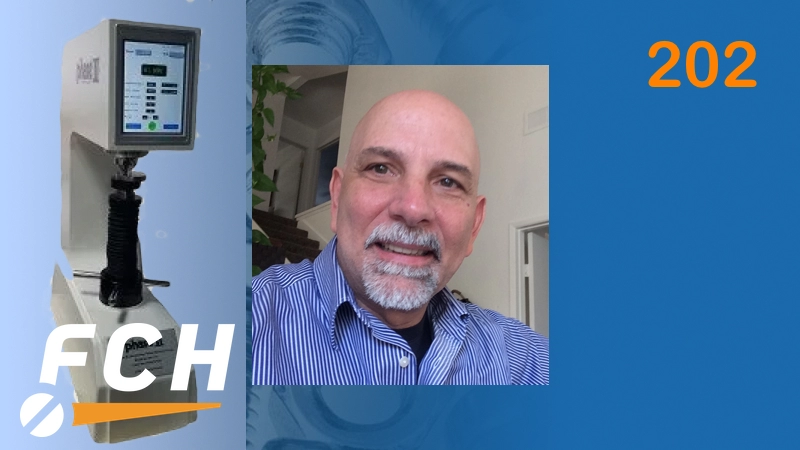This edition of the Fastener Training Minute with Carmen Vertullo was originally published July 20th, 2024 as “What is the difference between macro hardness testing and micro hardness testing during episode 202 of Fully Threaded Radio.
Well hello everyone, this is Carmen Vertullo with the Fastener Training Minute, coming to you from Fastener Training Institute and Carver Labs in beautiful El Cajon California.
Today’s topic, as usual, comes from a question from one of my students. This time it was in a class that we taught in beautiful Vancouver B.C. just a few weeks ago, at the beautiful facility of Fuller Metric. We had a small class and it was fairly intensely technical, and we talked about tensile strength and hardness. And one of the general questions that was asked was; why do we use macro hardness and why do we use micro hardness when testing hardness of fasteners and what’s the difference between the two? Well it was an excellent question and got us down a couple of really good rabbit holes. When I come back I’ll give you a brief explanation about the difference between macro hardness and micro hardness when testing fasteners.
Welcome back everybody. Today we are talking on the Fastener Training Minute about hardness testing of fasteners and specifically the difference between macro hardness and micro hardness.
Well, let’s start with macro hardness. You have all heard the term Rockwell Hardness testing. Well that is generally going to be what we consider to be macro hardness. A large scale hardness, and what that means is we have a very large load. We have an indenter and we’re going to push it into the material, and we’re going to measure the depth of the penetration, and that’s going to give us an indication of the hardness of the material. These tests are required by virtually every fastener standard, for example SAE J429 where Grades 2, 5 and 8 come from, and ISO 898 part 1 where our property classes 8.8 and 10.9 and 12.9 come from. And sometimes they refer to other standards to do the test SAE J429 sends us to ASTM F606 the fastener testing standard, to tell us where on the part we do the test. ASTM F606 sends us to a standard called ASME 8 that tells us how to actually do the hardness tests and so on, but in any case we have to understand what is going on with the Rockwell hardness test. Well first off there are several different scales. The two that matter most to us are the C scale and the B scale. The C scale is for harder materials such as alloy steel socket screws and Class 12.9 and Grade 8 bolts, and the B scale is for the softer materials such as brass and Grade 2 and A307. Anything that’s not heat treated, and probably Grade 5 is in there a little bit because it kind of crosses the boundary between the 2 scales, which by the way do not overlap and cannot be converted one to another. Some fastener test scales can be converted one to another, but not B and C, except that a really small area where the hardness of the C scale is really low and the hardness of the B scale is really high, but that’s not important.
So the C scale uses a diamond indenter. It’s a little thing that looks like the end of a pen it’s a conical-shaped diamond. We conduct the test on some kind of a machine that is typically going to be automated and digital or if you have an older style manual machine (actually they still make them). Those machines are also very good and less expensive, but the machine regardless of whether it’s automatic or manual, does most of the work for you. In essence once the specimen has been properly prepared, (that means you have to have flat and parallel surfaces top and bottom and the surface that you test on must be clean and free of debris and plating and paint and relatively smooth), you grind it smooth, making sure you don’t overheat it when you grind it. Then we apply a load, or the machine applies a load on the indenter, it’s called the minor load in the case of the Rockwell C scale. That load is only 10 kilograms that load sort of finds zero; it’s a way to settle everything out okay. Now we have a starting point. Once the machine has applied the minor load it then applies the major load which is 150 kilograms, and that drives the indenter deep into the material. By deep it’s not that deep, it’s a few thousands of an inch. After that, it dwells for some time and then the load is released, and the machine with its precision micrometer, measures the depth of the penetration between that minor load and the major load. Now the problem with that is that the deeper the penetrator goes into the material, the softer the material is. However the Rockwell hardness number as the material gets softer gets smaller so how do you go from a large number for soft to a small number for soft? Well how they do it is they have a formula they run it through. It gets subtracted from another number and that’s how we end up having a deep indentation giving us a smaller final result and the Rockwell C scale number starts around uh HRC 25 at the low end and go up to about HRC 70 for the high end. And a high end would be very hard, like carbide drill bits, stuff like that. Our fasteners are generally going to be in the HRC 28 to HRC 44 range for Rockwell hardness. Dowel pins may be up in the HRC 50. And that’s how we say HRC 50 Rockwell, HRC 43 Rockwell or 43 HRC Rockwell.
Now the other scale is the B scale, and it does not use a diamond inventor. The principle is the same, it uses an indenter that’s a very small ball. It’s a 16th of an inch diameter carbide ball. Sometimes you’ll hear HRB called HRB W on the B scale and the W just stands for Tungsten. It’s a Tungsten Carbide ball same exact principle, except the major load is lower it’s only 100 kilograms everything else is exactly the same and of course that indentation instead of looking like a little volcano as in the C scale it just looks like a little ball had bounced or hit the material. Generally we take more than one reading, three readings for example would be average. There’s a test called an arbitration test where if we have any kind of controversy, we would slice the end of the fastener off and do the test mid radius on the end that we sliced off, and we do 4 readings and average those readings. But generally you can take the test anywhere on the fastener that you have access to: the side of the head, the top of the head, even the round surface. If we’re going to do it on the round cylindrical surface there’s a correction factor we use for that, because that can affect the results especially, on very small diameters. So that’s the Rockwell B and C scale, and that’s mostly what we use for testing fasteners.
Now there’s another fastener test called the Vickers hardness test, and it’s called micro hardness testing, and it’s much more sophisticated, much more expensive, and takes a lot more time to conduct, because the preparation of the sample is intense. The Vickers hardness test also uses a diamond indenture, but it’s very small and it’s pyramid-shaped, and the loads are very small, and there are multiple loads but it’s the same scale from 10 kilograms up to I think a whole kilogram for the Vicker’s scale, and it’s used when our specimens are very small or we need to look very closely at the material. So let’s say for example, we needed to do a micro hardness test on a #4 split lock washer that is much too small to fit the Rockwell hardness test machine. We have to take the sample of that little lock washer and we mount it in plastic in a machine called a mount mounter, and then we polish that sample down until we can see a mirror finish of that little lock washer, take it to the machine, and the machine is totally automated. There’s nothing a human can do in terms of applying the load. Then we have a microscope on that machine and we have a measuring method in it, and some are manual for the measuring, some are automated. I prefer the automated one and that’s what we have here at Carver Labs. The load is applied and removed, and we see an indentation that looks like a diamond, because imagine you took a pyramid and mashed it into something soft, it leaves behind a diamond impression. Then we measure the distance between the corners of the diamond. The bigger that distance, the deeper the penetrator went, and thus the softer the material.
If we have very large parts there is also a test called a macro Vickers. We don’t do that very often here, but we can use a higher load.
But the the micro Vickers is the most common. And so it’s used to test very small parts but it’s also used to test one other thing which is very important, and that’s surface condition. That is, if we wanted to know what the hardness was at the very edge of the surface of a part, we would mount and polish that again, and put it under the microscope, and we can get very close to the edge of the part with that. So we can see what the hardness is at the surface, because surface hardness is an important thing that we measure, for tapping screws for example, or any case-hardened part. But we don’t only want to know what the surface hardness is, we also want to know how deep it goes, and because these indentations are so small you cannot see them with the naked eye. Well sometimes if you hold the mount and angle it just right in the light, you might see little reflections, but they’re so small you can’t see them. So we back off from the surface a few thousands of an inch at a time, and we continue to measure the hardness until the hardness stops dropping. At some point we’re at the core hardness and so that’s how we can know how deep the case step is, and that’s a very important test for tapping screws as well.
I’m going to go back to Rockwell hardness here just for a minute, because there are a couple of other scales that are useful in the Rockwell scale and the Rockwell hardness test regimen. There is an A scale which we never see in fastener standards, but it is a scale that does completely cover all of the C and the B scales, so it’s a very large scale, but it’s not very accurate. It’s only a 60 kilogram load and because of the fact that it is such a large scale the resolution is only about half that of the B and C scales, but it is useful sometimes.
Then we have a scale called the N scale and there are actually three N scales, 15, 30 and 45, and those are just like the C scale with the diamond indenter, except they use a very small load at 15, 30, and 45 range. 15 means 15 kilograms, 30 is 30 kilograms and 45 is 45 kilograms. And we use this scale when we want to know something only about the surface or superficial hardness of the part, and this can help us to find problems with the fasteners such as carburization or decarburization. By the way, Vickers hardness is also a way to check for decarburization that would indicate as a very soft material close to the surface.
Back to the N scale. We don’t see the requirement for superficial hardness in fastener standards very much, but we do see it in SAE J429, it is a requirement for Grade 5 and Grade 8 fasteners.
Finally there’s another scale similar to the N scale and it’s called the T scale, and it uses the same 16th inch ball as the B scale, and the same 15, 30 and 45 kilogram loads that the N scale uses. And again it helps us when we have small thin parts, or we just want to see what’s going on on the surface. Finally I would just say with all hardness testing, preparation is absolutely the key. You have to prep the sample well and knowing that your readings are accurate is key. And the way we know that our readings are accurate is that before we use the machine, we always put what’s called a certified test block in it of a known hardness, and that way we can rest assured that our machine is accurate and hopefully our setup is good.
Well I hope you learned a few things about the difference between macro hardness and micro hardness when it comes to testing fasteners. We do all of that stuff here at Carver Labs and if you hear this I will tell you what, if you call me or send me an email, we’ll give you a free hardness test of any type that you want here at Carver Labs even if you want us to do it just for fun.
Well this has been this is Carmen Vertullo with the Fastener Training Minute, thanks for listening.




![[GC2610] Solution_FCH Banner_[220x100] copy](https://news.fastenersclearinghouse.com/wp-content/uploads/2025/09/banner_solutionind.jpg)

